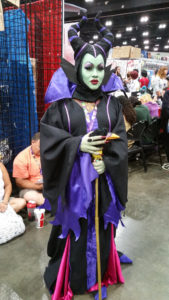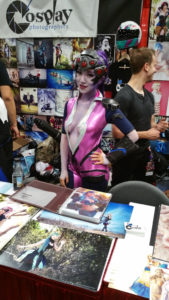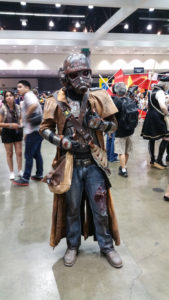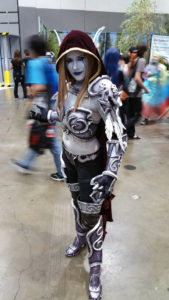Opinion: Geeks Play Dress-Up
Geeks love it, hate it, live it and breathe it. Cosplay is a subculture surrounded by unity, community and controversy.
There are no restrictions in the cosplay community. All are welcome no matter the age, shape, gender, sex or ethnicity. Everyone can freely and comfortably express themselves through their cosplay.
Costuming or masquerading is thought to have begun in the late 1930s. Initially it was not required to portray a specific character but rather emulate a genre, such as science fiction or superheros.
With its recent growth in popularity, cosplay has evolved into much more than just throwing on a costume to attend a convention. It became its own subculture in North America.
Cosplay is a core part of conventions. It is no longer specific to science fiction, but instead a multitude of genres across various mediums and platforms. These include video games, historical figures, anime, comics, cartoons, television, movies and originally designed characters.
I found a strong sense of unity diving into this world, a place for people to find themselves. Through this community I have been able to move past much of my social anxiety by creating and sharing my costumes with like-minded and welcoming individuals.
I have always loved to dress up. The feeling I had as a child putting on a costume for Halloween or playing in my room has always given me a sense of comfort. I could be anything I wanted to be, and once I put a costume on no one could convince me otherwise. I was inspired to make most of my Halloween costumes myself at a very young age.
I first decided to cosplay at a convention in 2013. I had been to conventions before, but didn’t think I would feel comfortable dressing up. I was so nervous. I worked extremely hard on making my cosplay: a maid costume.
The costume consisted of a simple black and white dress with cuffs, a headpiece, white stockings, black shoes and was topped off with a long white wig. It took me about a month to gather all the pieces and sew them together, primarily by hand since my sewing machine decided to be a jerk and give me trouble.

Con-goer dressed as Disney evil Queen Maleficent poses for photo on July 3, 2016 at Anime Expo.
As I arrived at Anime Expo with a group of friends, I felt very insecure. I felt I wasn’t going to fit in and thoughts of being ridiculed and judged by other goers crossed my mind. It made my skin crawl, and for a short time that seemed to stretch on my anxiety got the best of me.
It took a stranger also dressed as a maid running up to me in complete excitement at the fact that we were both maids in a sea of princesses, woodland characters and comic book characters to snap me back to reality. She caught me way off guard.
She asked to take a few photos together, I reluctantly agreed and once we were done she gave me the warmest hug and disappeared into the crowd of people. Thanks to this amazing stranger, I was able to enjoy the rest of the convention the way it was intended to be enjoyed.
One of my recent cosplays was a character from a video game series called “Blazblue.” The character Taokaka was a unique take on the catgirl archetype with brown skin, long blond hair tied up into two braids and a black cat tail with a faded white tip. She has happy-go-lucky personality and only wishes the best for her friends and family.
Through this character, I was able to find the confidence to interact with other con-goers despite my introverted personality. I was able to my share stories of past conventions with newly made friends and build lasting friendships by keeping in contact through social media outlets such as Facebook and Instagram.
I feel that once I don my cosplay, however simple or elaborate, I embody that character. By becoming them, I gain some of their confidence. I tend to cosplay as characters that I relate to but are more outgoing than myself.
I found that I was not alone in this feeling after talking to students that are also part of the community. “I started going all out with makeup and wigs,” said Khayla Lara, 28, kinesiology major. “I feel that it made me get out of my anxiety.”
Based on my experiences, one common factor with most people I spoke to is that we all deal with some sort of anxiety and through cosplay we found a form of relief. The characters we portray give us the confidence in ourselves to step out of our shells.
“Cosplay gives me a chance to express myself in ways I otherwise don’t get to very often. It’s a creative outlet in many aspects, and being in a mostly welcoming environment in which people just a want to have fun with other nerds is pretty rewarding,” says Alex Williams, 25, psychology major.
There are many people in the cosplay community that have gained quite the following, to the point of making a career out of their hobby earning the title “Professional Cosplayer.”

Professional cosplayer Stella Chu poses for photo on July 4, 2014.
One of these cosplayers is Jessica Nigri, 29, who has been able to use her cosplay skills to make a viable career.
Nigri, despite admitting to not making all of her cosplays herself, is probably one of the most lucrative cosplayers in the world.
She pulls in revenue through a variety of income sources including special guest appearances at conventions, Youtube videos and a Patreon account where people can pay for photo-sets on a per item basis or pay monthly for different tier of regularly distributed content.
Depending on how active she chooses to be, Nigri can make $800 to $11,000 a month off of Youtube alone with over one million subscribers. Her Patreon includes around 3,200 patrons, each paying at a minimum of $10 monthly to bring in roughly $32,000 a month.
One thing I really like about Nigri is her bubbly personality and how she strives to embody the characters she is cosplaying. I feel she did an amazing job on Reinhardt from the game Overwatch, a cosplay for which she made the armor and large hammer herself. It is not an easy task to create cosplay armor that looks as though it is worn yet has a slight shine to it out of non-metal materials.
However, some would argue that Nigri contributes to an issue present in the cosplay community.
This issue is the obvious hypersexuality of characters that are being cosplayed.
You see this on Halloween when searching for a simple adult size princess costume and are bombarded by “sexy” princesses instead. I have come across many individuals that will take a character like Ash Ketchum from Pokemon and wear a short crop top, vest and even shorter skirt instead of the character’s t-shirt, jeans and vest featured in the popular children’s cartoon and games. In an environment that is primarily family friendly, this can be problematic for many parents.

Con-goer dressed as Star Lord, from Guardians of the Galaxy, poses for photo on July 3, 2016 at Anime Expo.

Con-goer dressed as Ashe, from online comupter game League of Legends, poses for photo on July 3, 2016 at Anime Expo.
Another issue in this community is the elitists. Some people believe that an individual must look a certain way or be a certain size in order to successfully cosplay a character and feel justified in shaming others because of their notoriety within the cosplay community.
One example is cosplayer Mariah Mallad, 22, better known by her stage name Momokun. Her quick rise to fame in early 2016 was due in part to her outspoken views on body positivity within the community and her strong stance against sexual harassment at conventions.
All that came into question in June 2018 when Youtuber Kurt Mayer posted a video on his channel titled “Momokun sexually harass person at a con.” In the video, she appears to grab a con-goers backside without his consent and seemingly handles the situation as if it were a joke.
This video ultimately became the start of many accusations against her for sexual harassment and began her steady decline in popularity.
In early July 2018, two other notable cosplayers within the community known by their stage names Bunny Ayumi (Natalie) 25 and KayBear (Kay Thomas) 23, tweeted their experiences of Mallad’s transgressions in response to a Twitter post promoting Mallad’s meet-and-greet at the Anime Expo.
“I usually keep my mouth shut, but since I now realize I am not alone I feel like I will say something. Mariah has also touched me w/o my permission when we first met at Otakon Vegas. She pulled my top down while I was in cosplay & exposed my nipple in a bathroom full of people,” tweeted Thomas.
“Sexual harassment should not be dismissed. It is not easy to come forward, but I have gained the courage to speak up. At AX last year, Momokun slapped my ass in front of a large crowd without my permission after I had just met her,” Natalie tweeted in the days following.
It is not only the more notable con-goers that can be a cause for concern when attending a con. Problems also lay with the standard goer, those who attend conventions but choose not to dress as a character. Occasionally there will be an individual attempting to get too handsy with the cosplayers, claiming the revealing outfits entitle them to do so.
Any form of sexual harassment in any situation is not OK. I have been lucky enough not to deal with anything of the sort while attending a convention, but was made aware of situations in which other con-goers have.
These issues are rarely easy to talk about, but I feel the brave individuals that come forward about their experiences are helping others come forward as well as making the fight for change more attainable.
The cosplay community is filled with people working to keep this subculture a safe and welcoming place for all that venture to this once small realm.
In 2014, the group Geeks For CONsent pushed for stronger protective measures at San Diego Comic-Con and New York Comic-Con to protect con-goers.
“They were the unfortunate recipient of the first wave of public awareness,” says Rochelle Keyhan, one of the founders of Geeks For CONsent, of the San Diego event.
A petition was launched asking for San Diego Comic-Con to strengthen its code of conduct policy, increase anti-harassment signs and information and train volunteers to handle complaints. The convention operators declined. Luckily, the geek community did not accept that response.
In the summer of 2014, a guerrilla public relations campaign remained insistent in their efforts for change during San Diego Comic-Con by using signs, handing out flyers and continuing to press the staff.
Soon after, New York Comic-Con convened a panel leading to the establishment of strong anti-harassment guidelines. These included detailed descriptions of unacceptable behavior and a way to report harassment within the NYCC app. It has a GPS tag to help convention volunteers quickly find victims of harassment.
“After that, we got messages from conventions across the world asking us to either vet their policy or tweeting their policies at us so we were aware they had one,” Keyhan said.
Everyone wants a safe place to practice their hobbies and are working so hard to maintain that safe place in the cosplay community. Negative circumstances like those listed above are few and far between based on my personal experiences attending cons. I hope they will not deter you from taking a step into the world of cosplay.
Cosplay played a big part in my ability to meet people of many different backgrounds. It has contributed to or inspired many creative processes in relation to my artwork and has given me a sense of belonging.

Convention goers fill the convention hall on July 3,2016 at Anime Expo.
There are no words that can prepare you for your first day of your first con. I walked onto the floor of the convention hall and saw the wonder, imagination and creativity of a people who only wanted to dress up and have fun. We are just geeks playing dress-up and looking for a safe place to do so.



